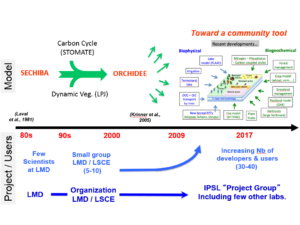Strategic Plan
Definitions
In this document, the ORCHIDEE-code refers to the land surface code ORCHIDEE, developed primarily (but not only) by members of the IPSL and labeled by the CNRS (“Code Communautaire”). The code includes the globally coupled, the regionally coupled and off-line versions.
The ORCHIDEE-model refers to the ORCHIDEE-code as well as the running environment, model drivers, data files of boundary conditions, initial state and benchmark variables, and the evaluation and optimization code.
The ORCHIDEE-project is an international community focused on developing numerical simulations with ORCHIDEE, with interests in understanding of the physical, hydrological, biogeochemical and biophysical interactions between land, atmosphere, and ocean. The ORCHIDEE-project is the management board of the ORCHIDEE-model, responsible for the “Community Code” that was labeled by the CNRS (ORCHIDEE-Code).
The ORCHIDEE-group includes all persons working with the ORCHIDEE-model or contributing to the ORCHIDEE-model.
Values
Recognition of diversity. The ORCHIDEE-project is a community of interdisciplinary scientists rich in professional and personal backgrounds. Members’ contributions to the ORCHIDEE project are judged solely on their scientific and/or technical quality. We are all respected whatever gender, nationality, funding agency, age, and/or educational background.
Open-science. The ORCHIDEE-project aims at developing the land surface model ORCHIDEE to provide a community tool. Driven by the open science principles, reference versions of the ORCHIDEE-code are shared following open-access and open-source principles.
Reciprocity. Members of the ORCHIDEE-group whose research relies on prior model tools, benchmark data, evaluation tools, optimisation tools, or results of the ORCHIDEE-project are expected to contribute to the mission of the ORCHIDEE-project in proportion to the use made of it.
Scientific ethics. ORCHIDEE-model developments are guided by our collective scientific interests in order to gain understanding and produce new knowledge. Developments aim at being transparent following strict principles of scientific ethics.
Equity. Within the ORCHIDEE-project, we promote collaborations based on mutual trust and equity as we believe sharing knowledge, code developments, data, and recognition strongly contributes to personal well-being, group cohesion, and success.
Cooperative decision-making. The management of the ORCHIDEE-project follows democratic principles, prioritizing decisions based on a consensus. This calls for setting aside prejudice, the willingness to listen, and mutual respect among the members of the ORCHIDEE project.
Climate responsibility. As we believe researchers can play their part in the fight against the climate and biodiversity crises, we collectively aim to lower the environmental impacts of research and its related activities (e.g., traveling) performed within the ORCHIDEE project.
Implications for the ORCHIDEE-project functioning
- These values serve as guidelines for decisions of the ORCHIDEE-project
- Create space and reserve time to discuss differences in opinions on the group functioning and find solutions to address these differences.
- Members of the ORCHIDEE-project volunteer to share responsibilities and tasks within the ORCHIDEE-project.
Vision
The ORCHIDEE-project aims to make the ORCHIDEE-model a globally recognized and leading LSM able to address scientific and societal challenges regarding the description and understanding of physical, hydrological, biogeochemical and biophysical processes and their interactions as well as major human-induced perturbations, underlying past, present and future climate change, and land-based mitigation and adaptation strategies.
Our vision relies on the following commitments :
- Staying united as a single ORCHIDEE-project
- Fostering collaboration with other labs and scientific communities (community tool)
- Maintaining an ensemble of state-of-the-art ORCHIDEE-model applications: global, regional and plot scales ; coupled (global and regional climate models) and stand-alone modes.
- Supporting climate (past-present-future) and process studies and further strengthening impact studies.
- Balancing (reflected in the model code) between scientific developments among physics, hydrology, biogeochemistry, ecology.
- Striving for a single code (trunk) with the smallest number of active and collaborative branches.
Implications for the ORCHIDEE-project functioning
- To stay innovative, key objectives are: (1) comprehensive and regular evaluations of the model, (2) a continuous effort in integrating existing developments (branches) into the trunk, and (3) a continuous effort to start new developments from the trunk.
- To avoid internal competition we have regular and dedicated meetings to inform the ORCHIDEE-group of each other’s planned developments.
- To work toward a single but versatile ORCHIDEE-code: pushing for modularity based on flags and regularly discussing the scientific developments that should be merged into the trunk.
- Sharing technical & support work across the ORCHIDEE-project (i.e., rights and duty for all users).
Mission
The ORCHIDEE-project coordinates model developments serving the ORCHIDEE-group through:
- developing new features, compatible with both off-line and coupled functionality of the IPSL-CM and RegIPSL atmospheric models
- Developing and testing new processes representations in branch versions with the ultimate aim to be integrated into the main version of ORCHIDEE if proven successful/relevant
Our developments aim at :
- Studying / representing all relevant natural and managed terrestrial land (among others, forests, crops, grass, deserts, glaciers, urban)
- Representing physical and biological processes with developments being done at the physically relevant temporal – from a few minutes to decades – and spatial – from the plot to regional and global – scales, while preserving the ability to run the model globally for centuries under past & future environmental and societal conditions.
The ORCHIDEE-project coordinates the release of stable and well-documented versions of the ORCHIDEE-model that will be made open access.
Stable : Shared ORCHIDEE-model versions
-
- have been evaluated and calibrated using a few internationally accepted forcing datasets
- are maintained with respect to the evolution of computing architecture at least 4 computing centers : IPSL and LSCE computing systems, TGCC and IDRIS.
Documented :
- For each shared ORCHIDEE-model version we aim to provide:
- Detailed meta-data information about the code and its running environment.
- Input data needed for or a set of pre-defined resolutions.
- Documentation about the pre-defined/default configuration setups as well as the ORCHIDEE-code.
- Evaluation of the new developments’ impact on the main energy, water, carbon and other nutrients budgets.
- A list of model options with instructions for defining physically-relevant and technically-constrained combinations of processes in complement to model diagnostic messages in the code.
- For each tagged version of the model we provide :
- Reference simulation outputs along with key performance diagnostics analysis
The ORCHIDEE-project is committed to :
- Create and safeguard a respectful and stimulating working environment for the ORCHIDEE-group.
- Promote the ORCHIDEE-project values in science.
- Maintain regular communication and good relationships
- Within the ORCHIDEE-group (especially with respect to the development of branches of the ORCHIDEE-code).
- With the other IPSL members and all initiatives around the ORCHIDEE-model.
- With research federations, funding institutes, data providers and other stakeholders.
Implications for the ORCHIDEE-project functioning
- Organize regular presentations of branch functionalities and objectives during ORCHIDEE-group meetings (ORCHIDEE – DEV meeting).
- Organize annual “merge” meetings to decide and plan on branch merging ⇒ set up guidelines describing criteria for branch merging.
- Improve the description of the ORCHIDEE-model versions supported by the ORCHIDEE-project (including a description of purposes and limitations and model parameter sets with warnings on combinations of resolution/processes).
- Have regular discussions on what to add to the ORCHIDEE-model evaluation procedure.


